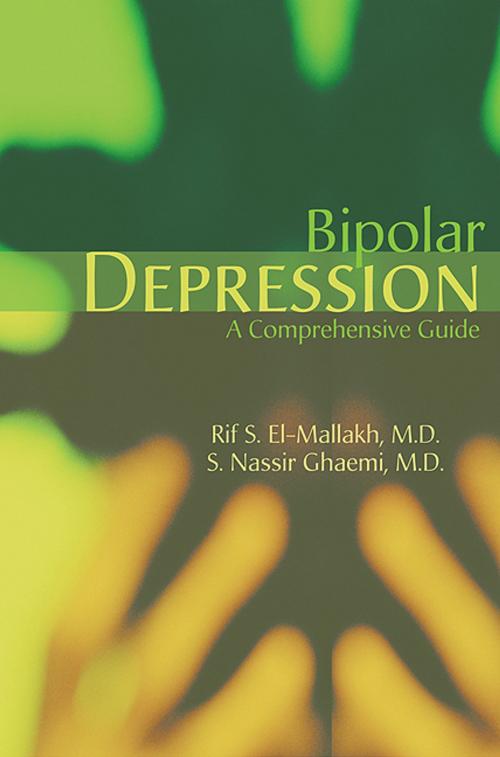Bipolar Depression
A Comprehensive Guide
Nonfiction, Health & Well Being, Medical, Specialties, Psychiatry| Author: | ISBN: | 9781585626519 | |
| Publisher: | American Psychiatric Publishing | Publication: | April 2, 2007 |
| Imprint: | American Psychiatric Association Publishing | Language: | English |
| Author: | |
| ISBN: | 9781585626519 |
| Publisher: | American Psychiatric Publishing |
| Publication: | April 2, 2007 |
| Imprint: | American Psychiatric Association Publishing |
| Language: | English |
Although depression is the most common presentation of bipolar disorder, correct diagnosis generally requires a history of mania and thus presents a formidable challenge. This book provides clinicians with the necessary guidance to distinguish this illness and pursue an appropriate therapeutic course. It brings together a team of clinical investigators who offer cutting-edge research on the topic and address the most critical concerns regarding its treatment.
Bipolar Depression first introduces a hierarchical model for diagnosis to allow the clinician to distinguish between bipolar and unipolar depression, addressing problems of misdiagnosis and overdiagnosis as well as differentiating attention-deficit/hyperactivity disorder (ADHD) and bipolar disorder. Early chapters review the neurobiology and genetics of this highly heritable condition, presenting studies of neurotransmitter function and brain imaging studies and documenting the susceptibility of specific chromosomes as loci for bipolar disorder. Other chapters address the particular issues of bipolar depression in children, for whom a diagnosis is especially problematic, and suicide, focusing on the need for assessment during both acute and maintenance treatment with interventions appropriate to a patient's symptoms and history. Bipolar Depression offers critiques of specific treatment approaches: Lithium and antiepileptic drugs: featuring a review of the most recent research on the use of lithium, in which higher doses are shown to be effective, plus coverage of lamotrigine, valproic acid, carbamazepine, oxcarbazepine, and topiramate. Antidepressants: offering new perspectives on a complex field, including a discussion of the randomized clinical trial literature and observational studies on their use, and citing cautions regarding side effects. Antipsychotics: evaluating the difference between first- and second-generation medications and discussing their role in controlling acute depressions. Novel approaches to treatment: including the use of atypical neuroleptics, electroconvulsive therapy, transcranial magnetic stimulation, vagus nerve stimulation, ketogenic diet, omega-3 fatty acids, myo-inositol, and dopamine agonists. Psychological interventions: focusing on the inclusion of cognitive-behavioral therapy or interpersonal social rhythm therapy for nonmelancholic depressions in patients who had previously received psychoeducation.
Despite the past decade's advances in practice and research, there remains much room for progress in understanding and treating bipolar depression. This book blazes a trail toward that goal, opening new doors in recognizing differences between bipolar and unipolar forms of depression while offering both researchers and clinicians key insights into this troubling illness.
Although depression is the most common presentation of bipolar disorder, correct diagnosis generally requires a history of mania and thus presents a formidable challenge. This book provides clinicians with the necessary guidance to distinguish this illness and pursue an appropriate therapeutic course. It brings together a team of clinical investigators who offer cutting-edge research on the topic and address the most critical concerns regarding its treatment.
Bipolar Depression first introduces a hierarchical model for diagnosis to allow the clinician to distinguish between bipolar and unipolar depression, addressing problems of misdiagnosis and overdiagnosis as well as differentiating attention-deficit/hyperactivity disorder (ADHD) and bipolar disorder. Early chapters review the neurobiology and genetics of this highly heritable condition, presenting studies of neurotransmitter function and brain imaging studies and documenting the susceptibility of specific chromosomes as loci for bipolar disorder. Other chapters address the particular issues of bipolar depression in children, for whom a diagnosis is especially problematic, and suicide, focusing on the need for assessment during both acute and maintenance treatment with interventions appropriate to a patient's symptoms and history. Bipolar Depression offers critiques of specific treatment approaches: Lithium and antiepileptic drugs: featuring a review of the most recent research on the use of lithium, in which higher doses are shown to be effective, plus coverage of lamotrigine, valproic acid, carbamazepine, oxcarbazepine, and topiramate. Antidepressants: offering new perspectives on a complex field, including a discussion of the randomized clinical trial literature and observational studies on their use, and citing cautions regarding side effects. Antipsychotics: evaluating the difference between first- and second-generation medications and discussing their role in controlling acute depressions. Novel approaches to treatment: including the use of atypical neuroleptics, electroconvulsive therapy, transcranial magnetic stimulation, vagus nerve stimulation, ketogenic diet, omega-3 fatty acids, myo-inositol, and dopamine agonists. Psychological interventions: focusing on the inclusion of cognitive-behavioral therapy or interpersonal social rhythm therapy for nonmelancholic depressions in patients who had previously received psychoeducation.
Despite the past decade's advances in practice and research, there remains much room for progress in understanding and treating bipolar depression. This book blazes a trail toward that goal, opening new doors in recognizing differences between bipolar and unipolar forms of depression while offering both researchers and clinicians key insights into this troubling illness.















